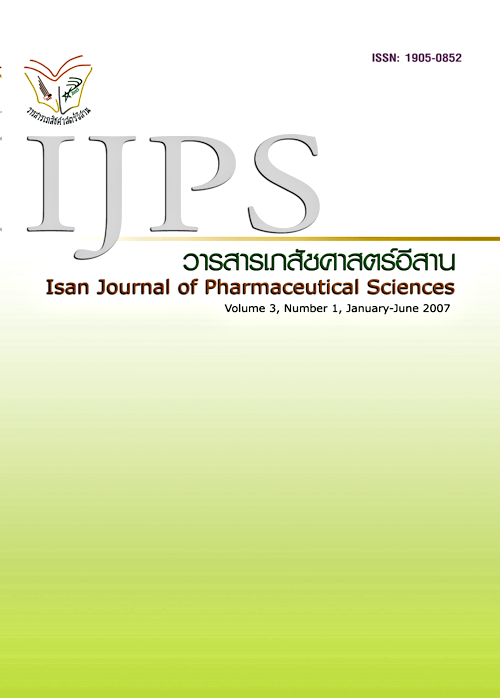Long-term Stability Study of Preservative-free Preparations of Morphine Injection
Main Article Content
Abstract
The objective of this study was to develop preservative-free morphine preparations for spinal injection to relieve pain for the patients who were not able to use the formulations with preservatives. From preliminary study of 14 formulations, it was found that preparations containing active ingredient, water, sodium chloride, and pH adjusted to approximately 4 were promising for long-term stability study. Therefore, four preparations of morphine sulphate injection at a concentration of 10 mg/ml were prepared. Each formulation was divided into 2 groups with and without flushing with nitrogen gas, prior to ampoule sealing. The prepared solution was filtered through 0.22 µm membrane filter under laminar airflow hood using aseptic technique and filled into 1 ml amber glass ampoules. The samples were kept at 25 ÌC/50%RH condition. Physical and chemical stability and sterility of the samples were tested periodically for 12 months. It was found that the most stable preparation was the formulation containing morphine and water for injection. Ninety eight percent of morphine was found during the storage period. However, color change in all samples was observed since 6 months of storage. Degraded product was observed in most of the samples since 6 months after storage according to the peak found in the HPLC chromatograms. Interestingly, all preparations with nitrogen flushing into the ampoules prior to sealing were more stable than those without flushing. All samples were still sterile as compared to the control samples during the study period.
Article Details
In the case that some parts are used by others The author must Confirm that obtaining permission to use some of the original authors. And must attach evidence That the permission has been included
References
Anderson PO, Knoben JE, Troutman WG. 2002.Handbook of clinical drug data. 10th ed.,McGraw-Hill Medical Publishing Division.Connors KA, Amidon GL, Stella VJ. 1986.
Chemical stability of pharmaceuticals,2nd ed., Wiley-Interscience, New York. pp.374.
Gaudette KE, Weaver SJ. 2003. Intraspinaluse of morphine. Ann. Pharmacother. 37:1132-1135.
Gleditsch E, Waaler PJ. 2001. Acceleratedstability studies of morphine injectionsin plastic ampoules. Int. J. Pharm. 212:257-287.
Grom JA, Bander LC. 1995. Compoundingof preservative-free high-concentrationmorphine sulfate injection. Am. J. Health.Syst. Pharm. 52: 2125-2127.
Grouls RJE, Korsten EHM, Yaksh TL. 1999.Spinal drug delivery. In TL Yaksh,General considerations in theformulation of drug for spinal delivery.Elsevier, Netherlands. pp 371-394.
McQuay HJ. 1990. The logic of alternativeroutes. J. Pain and Symptom Manage.5: 75-77.
Plotkowiak Z, Popielarz-Brzezinska M, LuczakJ, et al. 2004. Quality assessment ofmorphine hydrochloride solutions. Acta.Pol. Pharm. 61: 103-106.
Portenoy RK. Adjuvant analgesics in painmanagement. 1993. In: Doyle D, HanksGWC, MacDonald N. Oxford textbookof palliative medicine. Oxford: OxfordUniversity Press. pp 187-203.
Preechagoon D, Sumyai V, Tontisirin K, et al.2005. Formulation development andstability testing of oral morphinesolutionutilizing preformulation approach.J. Pharm. Sci. 18: 362-369.
World Health Organization. Cancer pain relief,WHO, Geneva. 1986.


